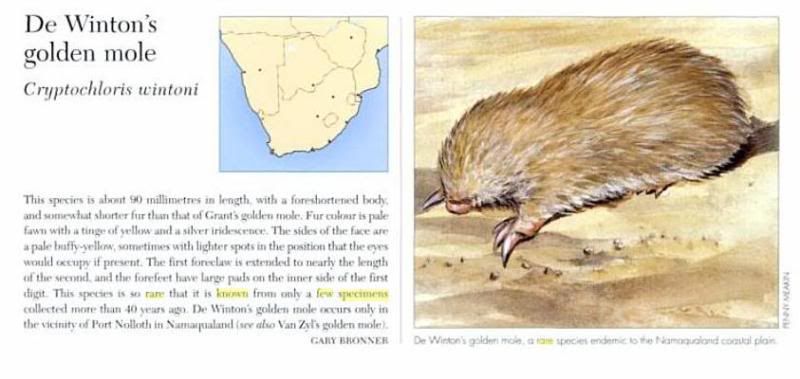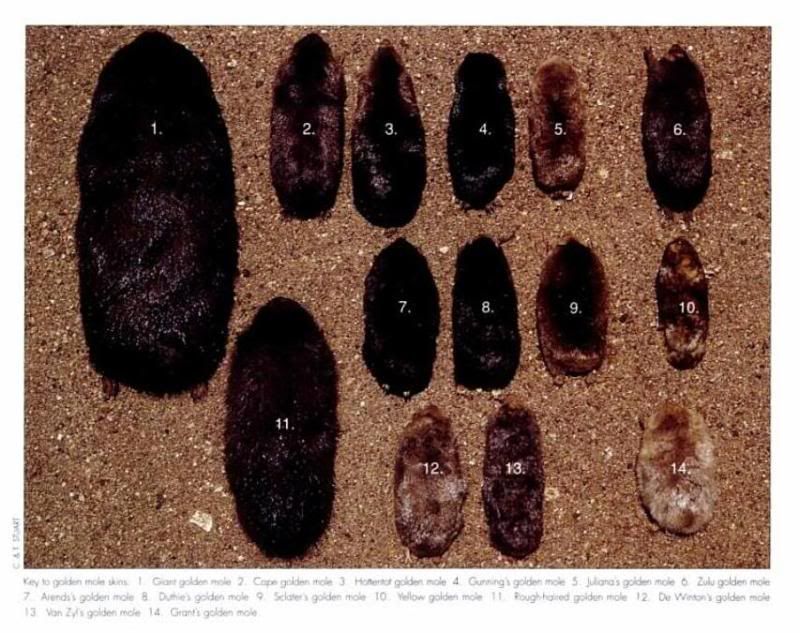|
|
Post by sebbe67 on Sept 2, 2006 20:16:25 GMT
Cryptochloris wintoni Classified as vulnerable in 1996, classified as Critically endangered in 2006. This species is endemic to South Africa. Recorded only from the type locality at Port Nolloth, Northern Cape Province, South Africa. Population Extremely rare; known from only three specimens and not captured for over 50 years. Total population indeterminable - no data. Habitat and Ecology Coastal dunes and adjacent sandy areas in Strandveld of the Namaqualand coastal plain (Nama-Karoo biome). Threats Habitat alteration as a result of mining of coastal sands for alluvial diamonds in the Port Nolloth district may pose a threat to this species; inferred from (Smithers 1986). Conservation Measures Fieldwork to survey for populations and assess the extent of anthropogenic threats is urgently needed. Research to clarify systematic status, and determine distribution limits and basic ecology is also a priority. www.iucnredlist.org/search/details.php/5748/all |
|
|
|
Post by another specialist on Sept 3, 2006 10:40:39 GMT
Taxonomic Notes Some authors (e.g., Simonetta 1968) treated this taxon as only subspecifically distinct from C. zyli, but these taxa differ consistently in pelage colour and malleus morphology, indicating that they are not conspecific (Meester 1974). Justification Known from only a single locality. Mining for alluvial diamonds is a potential major threat to habitat, minor threat is coastal development for tourism. Considered threatened (cf. Data Deficient) as no specimens have been collected for nearly a century. The existing evidence is that it is a valid species, and occurs in an area of high threat, so is listed as Critically Endangered. www.iucnredlist.org/search/details.php/5748/all |
|
|
|
Post by sebbe67 on Nov 1, 2007 11:17:52 GMT
 Source: Field Guide to the Mammals of Southern Africa |
|
|
|
Post by another specialist on Nov 1, 2007 21:42:28 GMT
great to see a pic of it. Thanks sebbe
|
|
|
|
Post by another specialist on Jan 7, 2008 8:07:13 GMT
|
|
|
|
Post by another specialist on Jul 9, 2008 16:51:37 GMT
Cryptochloris wintoni Author: Broom, 1907. Citation: Ann. Mag. Nat. Hist., ser. 7, 19: 264. Common Name: De Winton’s Golden Mole Type Locality: South Africa, Northern Cape Prov., Little Namaqualand, Port Nolloth. Distribution: Little Namaqualand, Northern Cape Prov., South Africa. Status: IUCN – Vulnerable. www.bucknell.edu/msw3/browse.asp?s=y&id=11100081 |
|
|
|
Post by another specialist on Oct 11, 2008 6:02:03 GMT
Taxonomy [top] Kingdom Phylum Class Order Family ANIMALIA CHORDATA MAMMALIA AFROSORICIDA CHRYSOCHLORIDAE Scientific Name: Cryptochloris wintoni Species Authority Infra-specific Authority: (Broom, 1907) Common Name/s: English – De Winton's Golden Mole Assessment Information [top] Red List Category & Criteria: Critically Endangered B1ab(iii) ver 3.1 Year Assessed: 2008 Assessor/s Bronner, G. Evaluator/s: Rathbun, G. (Afrotheria Red List Authority) & Hoffmann, M. (Global Mammal Assessment Team) Justification: Known from only a single locality, and not recorded for more than 50 years. The existing evidence is that it is a valid species, and occurs in an area of high threat, so is listed as Critically Endangered (Possibly Extinct). History: 2006 – Critically Endangered (IUCN 2006) 1996 – Vulnerable (Baillie and Groombridge 1996) 1994 – Indeterminate (Groombridge 1994) 1990 – Indeterminate (IUCN 1990) 1988 – Insufficiently Known (IUCN Conservation Monitoring Centre 1988) Geographic Range [top] Range Description: This species is endemic to South Africa. Recorded only from the type locality at Port Nolloth, Northern Cape Province, South Africa. Countries: Possibly extinct: South Africa Population [top] Population: Extremely rare; known from only three specimens and not captured for over 50 years despite survey work. Population Trend: Unknown Habitat and Ecology [top] Habitat and Ecology: Coastal dunes and adjacent sandy areas in Strandveld of the Namaqualand coastal plain (Nama-Karoo biome). Systems: Terrestrial Threats [top] Major Threat(s): Habitat alteration as a result of mining of coastal sands for alluvial diamonds in the Port Nolloth district may pose a threat to this species (Smithers 1986). Conservation Actions [top] Conservation Actions: Not recorded from any protected areas. Fieldwork to survey for populations and assess the extent of anthropogenic threats is urgently needed. Research to clarify systematic status, and determine distribution limits and basic ecology is also a priority. www.iucnredlist.org/details/5748 |
|
|
|
Post by another specialist on Dec 6, 2008 6:44:12 GMT
 The Complete Book of Southern African Mammals By M. G. L. Mills, Lex Hes |
|
|
|
Post by another specialist on Dec 6, 2008 7:00:16 GMT
 The Complete Book of Southern African Mammals By M. G. L. Mills, Lex Hes |
|
|
|
Post by Melanie on Jan 20, 2013 4:14:44 GMT
|
|
|
|
Post by Melanie on Jan 20, 2013 5:15:35 GMT
|
|
|
|
Post by Melanie on Jan 20, 2013 5:19:29 GMT
|
|
|
|
Post by Melanie on Jan 20, 2013 5:26:07 GMT
|
|
|
|
Post by Melanie on Jan 20, 2013 6:00:08 GMT
|
|
|
|
Post by Sebbe on Nov 17, 2020 18:50:45 GMT
|
|
|
|
Post by Sebbe on Feb 27, 2021 11:28:52 GMT
|
|
|
|
Post by Sebbe on Aug 14, 2021 6:11:19 GMT
|
|
|
|
Post by surroundx on Nov 3, 2021 1:55:02 GMT
|
|
|
|
Post by surroundx on Nov 28, 2023 1:52:08 GMT
|
|
|
|
Post by Melanie on Nov 28, 2023 9:21:47 GMT
Interesting news, but i'm missing photographes which confirm that this species is indeed rediscovered
|
|